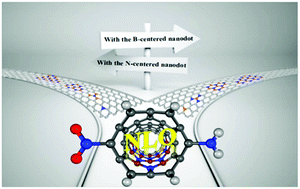Introducing the triangular BN nanodot or its cooperation with the edge-modification via the electron-donating/withdrawing group to achieve the large first hyperpolarizability in a carbon nanotube system
Abstract
Based on the ab initio calculations, we first investigated the nonlinear optical (NLO) properties of the doped carbon nanotube (CNT) systems with a triangular BN nanodot with the central B or N atom. Our computed results reveal that introducing the triangular BN nanodot can be considered as a new strategy to effectively enhance the first hyperpolarizability β0 value of a CNT system, and the type and size of the triangular BN domain have an important effect on the β0 value of the hybrid CNT system. In addition, the n-type doping by introducing the triangular BN nanodot with more N atoms, viewed as injecting electrons into the CNT system, can more effectively increase the β0 value of the hybrid CNT system when the doped domains have the same size. Moreover, the β0 value of the hybrid CNT system can be further enhanced by employing the electron-donating or -withdrawing group (NH2/NO2) to modify the appropriate nanotube-edged site to build the typical donor–π–acceptor framework, in view of the occurrence of a more effective charge transfer process. Evidently, this type of cooperation of introducing the triangular BN nanodot and forming the donor–π–acceptor framework can be considered as another new strategy to significantly enhance the first hyperpolarizability of the CNT system. These appealing findings can provide valuable insights into the design of novel high-performance NLO materials based on carbon nanotubes.



 Please wait while we load your content...
Please wait while we load your content...